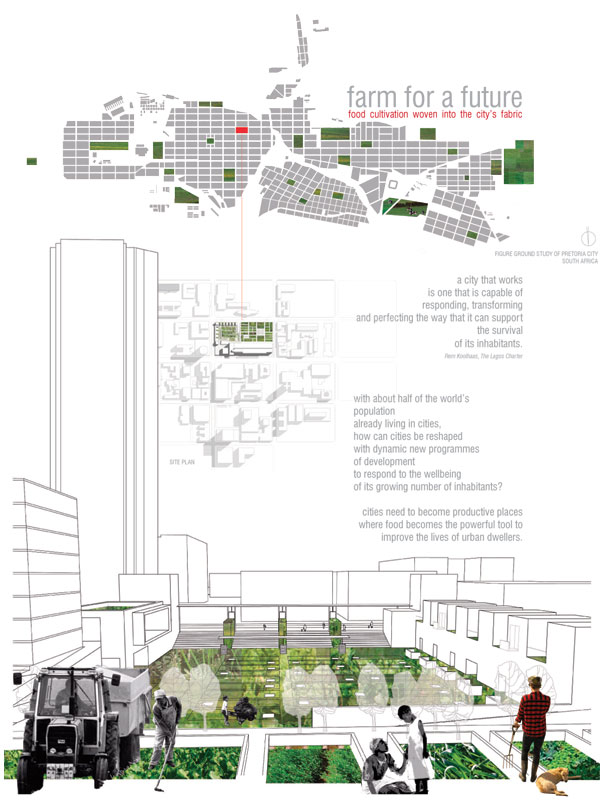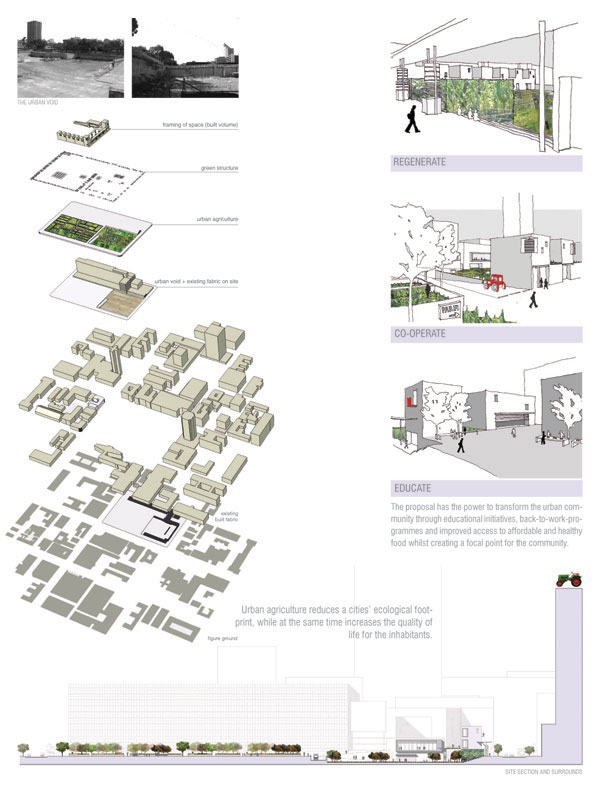
farm for a future by liani van der westhuizen from uk
designer's own words:
Rapid urbanization brings with a rapid increase in urban poverty and urban food insecurity. Urban poverty, inequality, sprawl and decentralisation are evident in South African cities as a result of apartheid’s policy of segregation, and needs to be addressed through sustainable regeneration. Urban tactics need to assist in the eradication of poverty by supporting people’s livelihood strategies aiding in social and human development. South African cities are also disconnected from food production, making them unsustainable and vulnerable.
Urban agriculture contributes to a wide variety of urban issues and is increasingly being accepted and used as a tool in sustainable city development. Currently the challenge is its integration into city planning and facilitation of its multiple benefits for urban inhabitants. This proposal defines a strategy for the coherent integration of urban agriculture into urban space planning, together with the creation of an urban area which attempts to reconnect urban dwellers to their environment. The case is made for considering urban agriculture as an essential element of sustainable urban infrastructure, resulting in greener city.
WHY URBAN FOOD?
Urban agriculture provides a complementary strategy to reduce urban poverty and food insecurity, improve nutrition, enhances local economic development and contributes to the greening of the city and the productive reuse of urban wastes. It plays an important role in improving urban food security since the costs of supplying and distributing food to urban areas based on rural production and imports continue to increase, and do not satisfy the demand, especially of the poorer sectors of the population. Urban agriculture makes use of residents as labourers and has direct links with the urban consumer. The proposal does not compete with rural agriculture, and should be seen as complementing it. Suggested produce includes products that require closeness to urban markets such as perishable fruit and vegetables, herbs, ornamental plants and even flowers.
SITE:
The proposed area of intervention is located in the city centre of the South African city Pretoria, on a vacant three meter deep urban wound adjacent to the official municipality headquarters, Munitoria. The west of Munitoria was gutted by fire in 1997, and eventually imploded. Numerous attempts to rebuild the complex have failed to date. The remaining built fabric is considered a landmark in Pretoria CBD, and contributes to the site significance.
The site’s proximity to key transit and pedestrian routes, its intimate relation to other landmarks in Pretoria and it’s potential to be incorporated into Pretoria’s open space strategy as a vibrant urban place make it particularly suitable for this multifaceted inquiry into issues such as urban sustainability, inner city housing, appropriate technology and urban renewal.
INTERVENTION:
The proposal includes the design of a series of multi-faceted spaces, simultaneously re-using the remains of the existing Munitoria building to densify the urban fabric and develop an interactive public environment. In addition to food and energy harvesting, the proposal purposefully incorporates program uses for residential and live/work units, office and agricultural research, tourist and educational facilities, and food related retail such as a large farmers market. The project also includes the following strategies to integrate city farming into the urban landscape in order to contribute to livelihoods and food security of the urban dweller: A community greenhouse, a community educational centre that house initiatives such as teaching people to grow food, back-to-work programmes, helping to develop and manage allotment and community gardens and assisting in the development of food-centred micro enterprises.
The project enhances the mixed-use programming to include urban farming as a reaffirmation of the importance of the connection of food to South African culture and daily urban life. The result will be a highly dynamic synergy of uses that compliment and support each other.
The proposal ultimately calls on city farmers, politicians, environmentalists, and regulatory bodies to work together to improve the long-term sustainability of urban farming as a major, secure source of food and employment for urban populations in South Africa.
farm for a future 01
 farm for a future 02
farm for a future 02